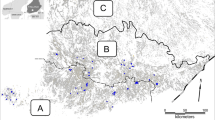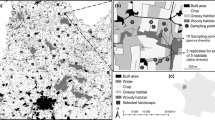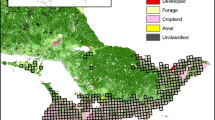Abstract
Nature reserves in Xeric Succulent Thicket of South Africa contain a greater diversityof wildlife and correspondingly a greater diversity of disturbance agents thanadjacent, unconserved freehold and communal rangeland. Although more lightlystocked, it is unknown whether protected areas contain a higher diversity oflandscape patches (i.e., sub-landscape features such as bush clumps,termitariums, bare patches or animal wallows) which could influence thereflectance value of a single pixel depicting a 20 × 20 marea in a SPOT satellite image, than unconserved land. Our key questions were:How does patch diversity in a nature reserve compare with that on commercial andcommunal rangeland? Can pixel diversity in a SPOT satellite image be used toquantify these differences? And, is there a correlation between reflectancediversity in a SPOT image and patch diversity on the ground? As a first step,the coefficients of variation (CV) for 10 groups of 12 picture-element (pixel)values of a dry season SPOT satellite image were calculated for two commercialfarms and a communal rangeland. The same data were collected on a naturereserve, 50 to 100 m inside the boundary between the reserve andthe freehold or communal rangeland. Next, we recorded the variety of 20 ×20 m plots on the ground, also in groups of 12 plots, at the samegeographical coordinates as the satellite-based measurements. The means of thesatellite-based and ground-based indeces were significantly and positivelycorrelated. In addition, the nature reserve displayed significantly higher pixelCVs than the communal rangeland, and also contained significantly higherground-based diversity indeces than the freehold, and possibly the communal,rangeland. We postulate that the higher landscape patchiness in the naturereserve is a result of the diversity of disturbances caused by wildlife(especially megaherbivores) coupled with naturally low stocking rates, while thelower diversity in the communally managed rangeland is the result of continuousheavy grazing coupled with intensive fuelwood harvesting. The satellite-basedtechnique is useful for identifying potential sites of high biodiversity,wherein more intensive sampling at a finer scale can be undertaken. It is,however, important to use dry season imagery because of the temporary‘masking’ effect of ephemerals during the wet season.
Similar content being viewed by others
References
Acocks J.P.H. 1988. Veld types of Southern Africa. Memoirs of the Botanical Survey of South Africa, no. 59. Dept. of Agriculture Technical Services, Pretoria, South Africa.
Ainslie A., Fox R. and Fabricius C. 1994. Towards policies for feasible and sustainable natural resource use: the mid-Fish River zonal study, Eastern Cape. Final report to the LAPC Natural Resource Management Programme. Rhodes University, Grahamstown, South Africa.
Baker W.L. and Cai Y. 1992. The r.le programs for multi-scale analysis of landscape structure using the GRASS geographical information system. Landscape Ecology 7: 291-302.
Bell R.H.V. and McShane T. 1984. Landscape classification. In: Bell R.H.V. and McShane-Caluzi E. (eds), Conservation and wildlife management in Africa. US Peace Corps, Washington, DC, USA, pp. 93-106.
Cullinan V.I. and Thomas J.M. 1992. A comparison of quantitative methods for examining landscape pattern and scale. Landscape Ecology 7: 211-227.
Fabricius C., Burger M. and Hockey P. 2002. Biodiversity in a protected area, and on commercial rangeland and communal land in Xeric Succulent Thicket, South Africa: terrestrial faunal assemblages. Journal of Applied Ecology (in press).
Forbes R.G. and Trollope W.S.W. 1991. Veld management in the communal areas of the Ciskei. Journal of the Grassland Society of South Africa 8: 147-152.
Forman R.T. and Godron M. 1986. Landscape Ecology. JohnWiley & Sons, New York, New York, USA.
Franklin J.F. 1993. Preserving biodiversity: species, ecosystems or landscapes? Ecological Applications 3: 202-205.
Friedman S.K. and Zube E.H. 1992. Assessing landscape dynamics in a protected area. Environmental Management 16: 363-370.
Kerley G.I.H., Knight M.H. and De Kock M. 1995. Desertification of subtropical thicket in the Eastern Cape, South Africa: are there alternatives? Environmental Monitoring Assess 37: 211-230.
La Cock G.D., Palmer A.R. and Everard D.A. 1990. Re-assessment of the area and conservation status of Subtropical Transitional Thicket Valley Bushveld in the Eastern Cape, South Africa. S.A. J. Photogram. Rem. Sens. Cartogr. 15: 231-235.
Lapin M. and Barnes B.V. 1995. Using the landscape ecosystem approach to assess species and ecosystem diversity. Conservation Biology 9: 1148-1158.
Low A.B. and Robelo A.G. (eds) 1996. Vegetation of South Africa, Lesotho and Swaziland. Department of Environmental Affairs and Tourism, Pretoria, South Africa.
Midgley J.J. and Cowling R.M. 1993. Regeneration patterns in Cape subtropical transitional thicket: where are all the seedlings? S.A. Journal of Botany 59: 496-499.
Mladenoff D.J., White M.A., Pastor J. and Crow T.R. 1993. Comparing Spatial Pattern in Unaltered Old-Growth and Disturbed Forest Landscapes. Ecological Applications 3: 294-306.
Moolman H.J. and Cowling R.M. 1994. The impact of elephant and goat grazing on the endemic flora of South African succulent thicket. Biological Conservation 68: 53-63.
Nilsson C. and Grelsson G. 1995. The fragility of ecosystems: a review. Journal of Applied Ecology 32: 677-692.
O’Neill R.V., Krummel J.R., Gardner R.H., Sugihara G., Jackson B., DeAngelis D.L. et al. 1988. Indeces of landscape pattern. Landscape Ecology 1: 153-162.
Palmer A.R. 1981. A study of the vegetation of the Andries Vosloo Kudu Reserve, Cape Province. MSc Dissertation, Rhodes University, Grahamstown, South Africa.
Palmer A.R. 1990. A qualitative model of vegetation history in the Eastern Cape midlands, South Africa. Journal of Biogeography 17: 35-46.
Palmer A.R., Crook B.J.S. and Lubke R.A. 1988. Aspects of the vegetation and soil relationships in the Andries Vosloo Kudu Reserve, Cape Province. S.A. Journal of Botany 54: 309-314.
Pino J., Roda F., Ribas J. and Pons X. 2000. Landscape structure and bird species richness: Implications for conservation in rural areas between natural parks. Landscape and Urban Planning 49: 35-48.
Recher D. 1969. Bird species diversity and habitat diversity in Australia and North America. American Naturalist 103: 75-80.
Rutherford M.C. and Westfall R.H. 1986. Biomes of southern Africa-an objective categorization. Memoirs of the Botantical Survey of South Africa, 54. Botanical Research Institute, Dept. of Agriculture, Pretoria, South Africa, 98 pp.
Scheiner S.M. 1992. Measuring pattern diversity. Ecology 73: 1860-1867.
Schluter D. and Ricklefs R.E. 1993. Species diversity: an introduction to the problem. In: Ricklefs R.E. and Schluter D. (eds), Species diversity in ecological communities. University of Chicago Press, Chicago, Illinois, USA, pp. 1-10.
Schulze E.D. and Mooney H.A. (eds) 1994. Biodiversity and Ecosystem Function. Springer-Verlag, Berlin.
Stuart-Hill G.C. and Aucamp A.J. 1993. Carrying capacity of the succulent Valley Bushveld of the Eastern Cape. African Journal of Range Forest Science 10: 1-10.
Tanser F.C. and Palmer A.R. 1999. The application of a satellite-derived landscape diversity index to monitor degradation patterns in the Great Fish River Valley, Eastern Cape Province, South Africa. Journal of Arid Environment 43: 477-484.
Tilman D. 1982. Resource competition and community structure. Princeton University Press, Princeton, New Jersey, USA.
USACERL 1994. GRASS 4.1 Geographic Resources Analysis Support System. US Corps of Engineers Research Laboratory, Champaign, Illinois, USA.
Whitford W.G., Dick-Peddie D., Walters D. and Ludwig J. 1978. Effect of shrub defoliation on grass cover and rodent species in a Chihuahuanan desert ecosystem. Journal of Arid Environment 1: 237-242.
Author information
Authors and Affiliations
Rights and permissions
About this article
Cite this article
Fabricius, C., Palmer, A. & Burger, M. Landscape diversity in a conservation area and commercial and communal rangeland in Xeric Succulent Thicket, South Africa. Landscape Ecol 17, 531–537 (2002). https://doi.org/10.1023/A:1021568611566
Issue Date:
DOI: https://doi.org/10.1023/A:1021568611566




